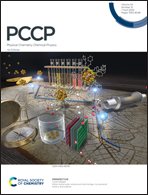Thermally induced electron–hole dissociation dynamics in quasi-one-dimensional bromo-bridged palladium(iii) Mott-insulator [Pd(en)2Br](Suc-Cn)2·H2O (Cn-Y = dialkylsulfosuccinate; n = 5 and 6)
Abstract
Current–voltage characteristics and dielectric properties were studied in bromo-bridged one-dimensional compounds, [Pd(en)2Br](Suc-C5)2·H2O, exhibiting mixed-valence and averaged valence (MV–AV) phase transition. In the AV phase, clear nonlinear current–voltage characteristics were observed. This phenomenon was explained by the thermally induced electron–hole separation assisted by an electric field. This mechanism was supported by the dielectric properties of [Pd(en)2Br](Suc-Cn)2·H2O (n = 5 and 6).
2·H2O (Cn-Y = dialkylsulfosuccinate; n = 5 and 6)](/en/Image/Get?imageInfo.ImageType=GA&imageInfo.ImageIdentifier.ManuscriptID=D2CP00051B&imageInfo.ImageIdentifier.Year=2022)


 Please wait while we load your content...
Please wait while we load your content...